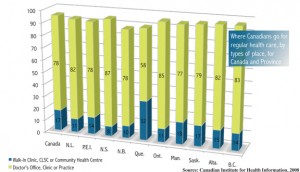By Steve knight/editor-in-chief
 With health insurance reform an emotional topic, Americans are looking north of the border at a health care system that most Canadian citizens, including university students, believe works well for them.
With health insurance reform an emotional topic, Americans are looking north of the border at a health care system that most Canadian citizens, including university students, believe works well for them.
According to a report released Sept. 10 by the U.S. Census Bureau, more than 46 million Americans, more than the entire population of Canada, did not have health insurance coverage in 2008.
Two Canadian college students said they and their colleagues were happy with their health care service, and one said she did not understand why the debate in American has become so heated and controversial.
“I don’t get this idea of overwhelming government control with social health care in the U.S. — I mean, here in Ontario, sure it was unfortunate when they decided that they couldn’t cover eye exams for citizens who weren’t children or seniors, but there’s definitely no feeling of ‘government control’ when it comes to health care here,” said Emma Godmere, editor-in-chief of The Fulcrum, the student newspaper at the University of Ottawa, in an e-mail.
“Doctors still have a lot of flexibility as I understand it, and I’m still pretty sure they get paid pretty darn well too. I’m able to set up an appointment with my family doctor whenever I need, completely free of charge.
“It’s true that many people have a hard time finding a family doctor of their own, but there are also general clinics — outside of the emergency room — that are often open outside of regular business hours and that once again don’t cost anything to go to. That’s probably the biggest benefit for any Canadian citizen.”
Most students rely on their parents’ insurance plan or a plan that the university offers for more coverage such as dental and eye care, Godmere said.
“Here at the University of Ottawa, all undergraduate students have basic health and dental insurance for only around $200 a year,” she said. “Since the basic Ontario Health Insurance Plan (commonly referred to as “OHIP” here) doesn’t cover dental, and only covers eye exams if you’re under 18, those external insurance plans can really help, especially when it comes to filling prescriptions or buying glasses.”
Under the Canada Health Act, residents receive free reasonable access to medically necessary hospital and physician services from a national health insurance program, referred to as Medicare, composed of 13 provincial and territorial plans.
Most Canadians may take for granted that they can go to a doctor’s office or clinic whenever they need and not concern themselves with major costs for health care.
Paul Bucci, coordinating editor of The Ubyssey, the student newspaper at the University of British Columbia in Vancouver, said in an e-mail that despite problems with funding, most are satisfied with the health care system.
“It is a relief to most to be able to walk into a hospital and be taken care of. That being said, we also have a population of roughly 33 million, and the more socialized system makes sense for a smaller population,” he said. “Our system is also better at taking care of the lower tax brackets.”
The British Columbia provincial government, although meeting opposition, is considering a plan that provides a combined federal and private health care system, allowing those who can afford it to receive better care, Bucci said.
“So the upshot of what I’m trying to say is that we like the system because it takes care of the little guy, which includes students, but there’s still room for improvement,” he said.
In a report by the Canadian Institute for Health Information, an Ottawa-based non-profit organization that collects and analyzes health information, 78 percent of those surveyed said they go to a doctor’s office and 17 percent said they go to a walk-in clinic or community health center when they are ill.
The survey showed that 65 percent of respondents said their care provider also allowed them enough time to discuss their feelings, fears and concerns about their health in the last year.
More than 75 percent of Canadians surveyed said they received excellent or very good care from their primary physician.
“Primary health care typically represents a patient’s first point of contact with the health system and includes a range of activities, from ongoing care for chronic conditions to care for urgent but minor or common health problems,” said Greg Webster, director of primary health care information at the institute in a statement.
The report also stated that 54 percent of surveyed Canadians needed routine ongoing care within the past year with 13 percent of those reporting difficulties receiving needed care.
The most frequent reasons given for this included wait time for an appointment, difficulty getting an appointment and difficulty contacting a doctor.
Of those needing routine or ongoing care, 68 percent received care in seven days or less.
The study shows that improvement was needed for patients with chronic diseases, such as arthritis, cancer, emphysema, diabetes, heart disease, high blood pressure and mood disorders.
Of the 40 percent reporting a chronic condition, at least one in seven did not have a treatment plan with their doctor in the last year while 23 percent were provided with a written management plan.
Also, 40 percent of patients reporting three or more chronic conditions said they rarely or never discussed options to improve their health with a doctor in the last year.
“Health promotion, disease prevention and self-management activities are particularly important to maintain health for all people and prevent complications for people who have chronic health conditions,” said Dr. Sharon Johnston, family physician and University of Ottawa professor, in the institute’s statement.
“This finding definitely points to the need for improvements in helping patients to take care of their health between primary health care visits.”






























